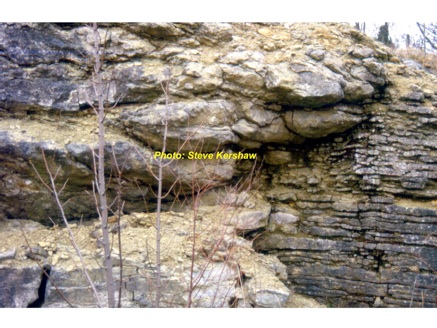Types of microbialites: a brief introduction
by Steve Kershaw




Types of microbialites: a brief introduction
by Steve Kershaw
PTB microbialites are dominated by stromatolites and thrombolites, and a comprehensive coverage of microbialite types is beyond the scope of this website; the reader is recommended to go into the literature, beginning with the references on this page, to learn more about the construction of microbialites. Only a brief introduction is given here.
A useful definition of microbialites that has become accepted is: "Microbialites are organosedimentary deposits that have accreted as a result of a benthic microbial community trapping and binding detrital sediment and/or forming the locus of mineral precipitation" (Burne, R.V., Moore, L.S. 1987. Microbialites: organosedimentary deposits of benthic microbial communities. Palaios 2, 241-254.). Four forms of microbialites were recognised by Riding (Riding, R. 2000. Microbial carbonates: the geological record of calcified bacterial-algal mats and biofilms. Sedimentology 47 (Suppl 1): 179-214). More recently, Riding (2008) showed that microbialites can be hybrids of organic and inorganic precipitation (Riding, R. (2008) Abiogenic, microbial and hybrid authigenic carbonate crusts: components of Precambrian stromatolites. Geologia Croatia, 61, 73-103). Some microbialites are shown below; photos by Steve Kershaw.
NOTE: there is potential confusion between thrombolite and dendrolite. Riding (2000) defined dendrolites as being composed of branched structures formed by microbial calcification; in contrast, thrombolites (along with stromatolites) can form by agglutination of carbonate particles. In the field there is the potential to confuse dendrolite and thrombolite, especially since some branching thrombolites are not made from microbial calcification, such as the digitate thrombolite shown above. Thin sections are necessary for useful study of microbial forms.
Stromatolite: layered structure in PTB of Turkey.
Thrombolite: clotted structure in PTB of Turkey.
Digitate thrombolite from PTB of Sichuan: clotted structure, but arranged into a branched form in some cases. Below is the rounded top surface of the digitate thrombolite at Laolongdong (Chongqing SAR)
Leiolite; structureless microbialite. Upper photo shows no clearly definable structure in this Silurian reef margin from UK: the reef margin is made of micrite, yet it has a sharp boundary with adjacent bedded sediments The micrite is therefore suspected to be microbially bound.
Lower photo shows thin section view of leiolite from the reef margin, with no clearly-defined structure of the micritic sediment. This is not just sedimented micrite, because it forms the sharp wall margin of the reef, in the absence of skeletal metazoan reef builders.
Hybrid microbialite: this sample (left photo) from PTB of Turkey looks like bedded limestone in the field, but in thin section (bottom composite photo) revealed a mixture of microbially-bound and inorganically precipitated carbonate, and deposited carbonate material.


Left: stromatolite from Late Triassic (the “Cotham Marble” of UK.
Below: thin section of stromatolite from Holocene reef in Greece.
1. Stromatolites are layered micrites and/or cements;
2. Thrombolites are clotted micrites;
3. Dendrolites are branching, but are made of calcimicrobes (skeletal fossils, rather than sediment);
4. Leolites are structureless (actually not completely amorphous, but do not have structures fitting the other 3 types of microbialite).
PT boundary microbialites are mostly stromatolites and thrombolites







